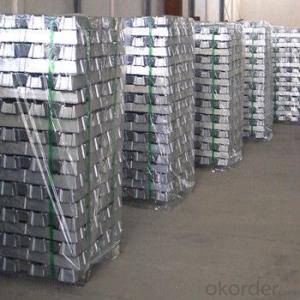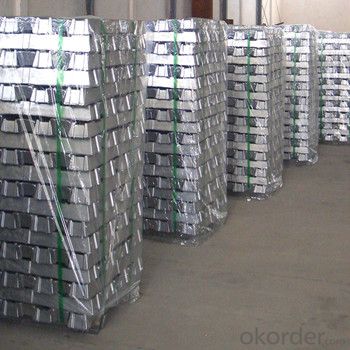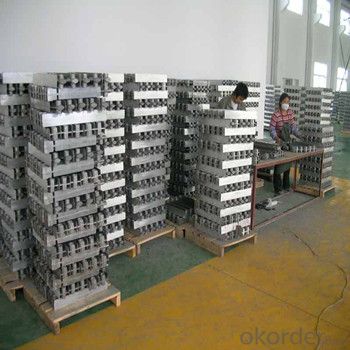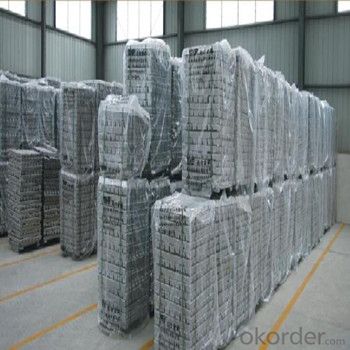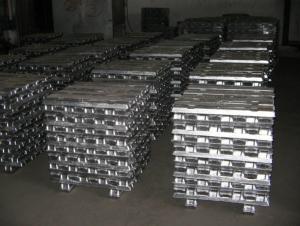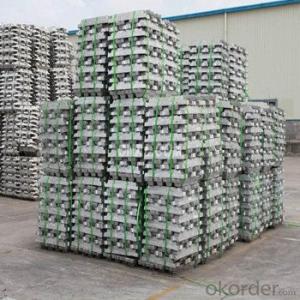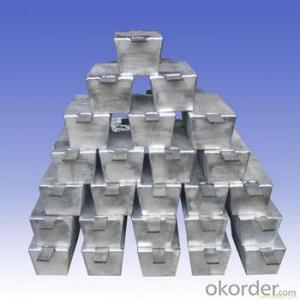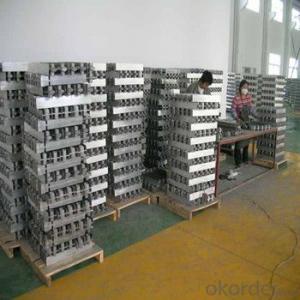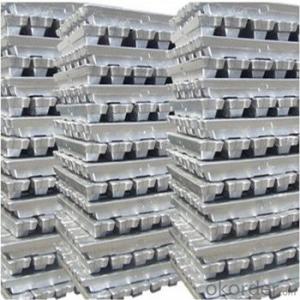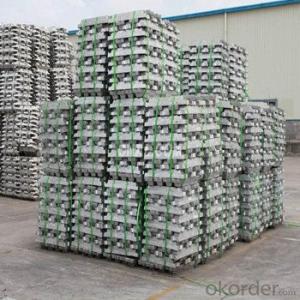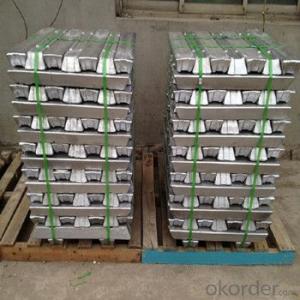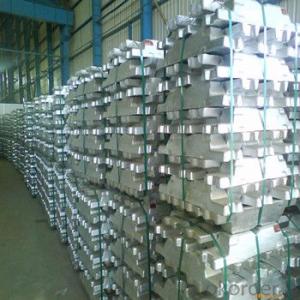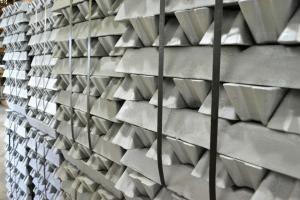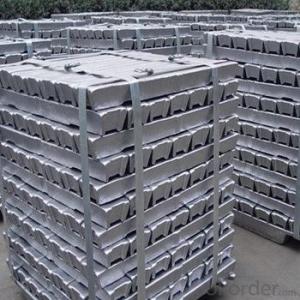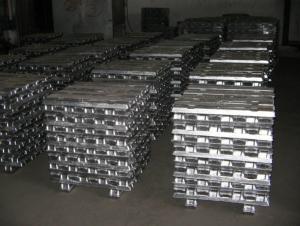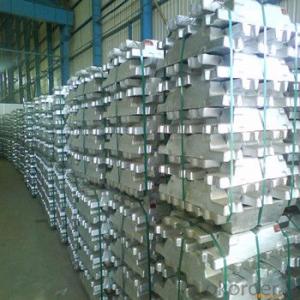Aluminum Pig/Ingot Exported From Chinese Manufacturers
- Loading Port:
- China main port
- Payment Terms:
- TT OR LC
- Min Order Qty:
- 1000 m.t.
- Supply Capability:
- 100000 m.t./month
OKorder Service Pledge
OKorder Financial Service
You Might Also Like
Pure Aluminum Pig/Ingot Used for Industry
1.Structure of Aluminum Pig/Ingot
A material that has been cast into a shape in order to be transported and processed easier than in an unprocessed form. An ingot is typically rectangular in shape, which allows it to be stacked. Ingots are most commonly associated with metals, with ingots of gold held in the vaults of banks and brokerages being popular images.
Aluminum Ingot is with the AL as the main chemical composition.Aluminum Ingot is used for industry,such as automobile,pinning and weaving,electron broadly and so on. Aluminum Ingot has the following advantages: easy control and operation, fast melting.
2.Main Features of the Aluminum Pig/Ingot
•High Purity
•Easy control and operation
•High strength
•Fast melting
•Competitive price
•Best Service
3.Aluminum Pig/Ingot Images

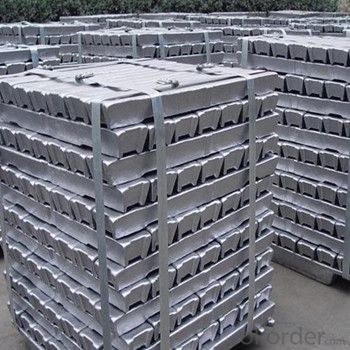
4.Aluminum Pig/Ingot Specification
Grade | Chemical Composition % | |||||||||
Al≥ | impurities ≤ | |||||||||
Si | Fe | Cu | Ga | Mg | Zn | Mn | others | Sum | ||
Al99.9 | 99.90 | 0.50 | 0.07 | 0.005 | 0.02 | 0.01 | 0.025 | - | 0.010 | 0.10 |
Al99.85 | 99.85 | 0.80 | 0.12 | 0.005 | 0.03 | 0.02 | 0.030 | - | 0.015 | 0.15 |
Al99.7 | 99.70 | 0.10 | 0.20 | 0.010 | 0.03 | 0.02 | 0.030 | - | 0.030 | 0.30 |
Al99.6 | 99.60 | 0.16 | 0.25 | 0.010 | 0.03 | 0.03 | 0.030 | - | 0.030 | 0.40 |
Al99.5 | 99.50 | 0.22 | 0.30 | 0.020 | 0.03 | 0.05 | 0.050 | - | 0.030 | 0.50 |
Al99.00 | 99.00 | 0.42 | 0.50 | 0.020 | 0.03 | 0.05 | 0.050 | - | 0.050 | 1.00 |
5.FAQ of Aluminum Pig/Ingot
We have organized several common questions for our clients,may help you sincerely:
①How about your company?
A professional manufacturers of the alumiun pig.Devoted in this industry for many years,so got much experice.The quality and service have also accepted by customer.Can meet customers' requiements to provide different grade and purity alumiun pig.
②How to guarantee the quality of the products?
We have established the international advanced quality management system,every link from raw material to final product we have strict quality test;We resolutely put an end to unqualified products flowing into the market. At the same time, we will provide necessary follow-up service assurance.
③How long can we receive the prod rking days, We will arrange the factory delivery as soon as possible. The pecific time of receiving is related to the state and position of customers.Commonly 7 to 10 working days can be served.
- Q: How much capital do I need to invest in the recycled aluminium ingot?
- There's no coke left now, too often. Are the basic carbon, and Shanxi coal, coal and bituminous coal is not done, too complex that do come in, now the industry is difficult to do, but it is not a hurry, hurry when. And they have to pay for it like a grandchild.
- Q: What are the different coating processes for aluminum ingots?
- Aluminum ingots can undergo various coating processes to improve their surface properties and protect against corrosion and environmental factors. Some commonly used coating processes for aluminum ingots include the following: 1. Anodizing: An electrochemical process is utilized to create an oxide layer on the ingot's surface. Anodizing not only provides excellent corrosion resistance but also allows for the application of dyes or paints to enhance the ingots' appearance. 2. Powder coating: Dry powder is applied to the ingot's surface and heated, resulting in the powder melting and forming a protective coating. This coating offers durability, aesthetic appeal, and resistance against corrosion, UV radiation, and chemicals. 3. Electrophoretic coating: Aluminum ingots are immersed in a paint solution that is electrically charged. The paint particles migrate to and deposit on the ingot's surface due to the electric field. Electrophoretic coatings provide excellent adhesion, corrosion resistance, and uniform coverage. 4. Chemical conversion coating: Aluminum ingots are treated with a chemical solution that reacts with the surface to create a protective coating. Common chemical conversion coatings include chromate, phosphate, and chromate-phosphate coatings. These coatings offer corrosion resistance and can serve as a base for paint or other decorative finishes. 5. Thermal spraying: A coating material, in the form of powders, wires, or rods, is heated and sprayed onto the ingot's surface. Thermal spraying results in a strong and durable coating that protects against wear, corrosion, and high temperatures. 6. Organic coatings: Liquid paints or lacquers are applied to the ingot's surface as organic coatings. These coatings provide a decorative finish and protect against corrosion and weathering. They are commonly used when aesthetics are a significant consideration. The choice of coating process depends on the specific requirements of the aluminum ingots and their intended application. Each process has its own advantages and disadvantages.
- Q: What are the common defects found in aluminum ingots?
- Aluminum ingots may exhibit several common defects. Porosity is one such defect, characterized by the presence of small voids or air pockets within the ingot. It can arise from improper casting techniques or insufficient degassing of the molten aluminum. Porosity weakens the overall structure of the ingot and diminishes its mechanical properties. Another defect frequently observed is segregation, which arises when alloying elements or impurities are unevenly distributed within the ingot. This leads to variations in composition and properties across different sections of the ingot. Segregation can be caused by improper alloying or inadequate mixing of the molten aluminum. Cracking is yet another defect often encountered in aluminum ingots. It may occur during cooling or solidification if there is rapid or uneven cooling, resulting in thermal stress and cracking. Excessive hydrogen content in the aluminum can also induce cracking by promoting the formation of internal cracks. Furthermore, surface defects, including dross, oxide films, and inclusions, are commonly found in aluminum ingots. Dross refers to impurities and oxides that float on the surface of the molten aluminum and become trapped in the ingot during solidification. Oxide films form on the ingot's surface due to exposure to air or inadequate protection during casting. Inclusions are foreign particles or non-metallic compounds that get trapped within the ingot during solidification. These defects significantly impact the quality and performance of aluminum ingots. Consequently, it is critical to employ appropriate casting techniques, control alloy composition, ensure sufficient degassing, and implement effective quality control measures to minimize the occurrence of these defects.
- Q: How much does it cost to process the aluminum ingots into T5-6063 models? Now, what about costing the aluminum ingot or the aluminum bar?
- Because of its good formability, it is generally processed into aluminum profiles, especially those with complicated cross sectionsAluminum ingot + mold fee + different sections of profiles processing costs varyI can contact you for more details
- Q: How are aluminum ingots used in the production of consumer goods?
- Due to their versatility and desirable properties, aluminum ingots have become widely used in the manufacturing of consumer goods. These ingots undergo a process of melting and transformation into different forms, such as sheets, bars, or coils, to suit various manufacturing processes. One popular application of aluminum ingots is in the production of packaging materials. Aluminum foils and cans, which are lightweight, corrosion-resistant, and malleable, are ideal for preserving food and beverages. The ingots are rolled into thin sheets, which are then used to create these packaging materials. The automotive industry is another major user of aluminum ingots. Aluminum's low density and high strength-to-weight ratio make it an excellent choice for manufacturing car parts, including engine components, body panels, and wheels. By utilizing aluminum ingots, automakers can produce lighter vehicles, leading to improved fuel efficiency and better performance. Moreover, aluminum ingots find extensive usage in the construction sector. These ingots are often extruded into profiles used for windows, doors, and curtain walls. Aluminum's corrosion resistance and ability to withstand extreme weather conditions make it a popular choice for building materials. Furthermore, aluminum ingots are employed in the production of consumer electronics. The lightweight characteristics of aluminum make it an ideal material for manufacturing laptops, tablets, and smartphones, where weight reduction is crucial for portability. The ingots are processed into casings, frames, and other components for these electronic devices. In summary, aluminum ingots play a crucial role in manufacturing a wide range of consumer goods. Their versatility, lightweight nature, and corrosion resistance make them suitable for various applications in industries such as packaging, automotive, construction, and electronics.
- Q: Can aluminum ingots be used in medical applications?
- Medical applications can utilize aluminum ingots effectively. Aluminum, known for its versatility and advantages in the medical field, offers lightweight properties, corrosion resistance, and excellent thermal conductivity. These qualities make it an optimal choice for a range of medical devices and equipment. Manufacturing medical devices like prosthetics, orthopedic implants, and surgical instruments can utilize aluminum ingots. These ingots can be precisely shaped and sized to meet specific requirements in medical applications. Furthermore, aluminum is commonly employed in the production of medical equipment such as MRI machines, X-ray machines, and dental tools. Moreover, aluminum ingots find use in the production of medical packaging materials. Aluminum foils, with their ability to act as a barrier against moisture, light, and oxygen, are ideal for packaging pharmaceutical products. This ensures the integrity and longevity of medications. It is crucial to emphasize that the utilization of aluminum in medical applications must adhere to strict regulations and guidelines to guarantee patient safety. Manufacturers must rigorously comply with quality control measures and conduct thorough testing to ensure the biocompatibility and safety of the final product. To conclude, aluminum ingots possess favorable properties that make them suitable for various medical applications. Nonetheless, it is essential to prioritize compliance with applicable regulations and standards to ensure the safety and effectiveness of the final medical product.
- Q: What is the melting point of aluminum ingots?
- The melting point of aluminum ingots is approximately 660 degrees Celsius or 1220 degrees Fahrenheit.
- Q: What are the challenges in recycling aluminum ingots?
- One of the challenges in recycling aluminum ingots is the energy-intensive process required to melt and extract aluminum from the ingots. Additionally, impurities such as coatings, paints, or other contaminants on the ingots can hinder the recycling process and require additional steps for purification. Furthermore, the collection and sorting of aluminum ingots from various sources can be logistically complex and time-consuming. Lastly, ensuring a consistent supply of high-quality aluminum ingots for recycling can be challenging, as it depends on factors like consumer behavior, recycling infrastructure, and market demand.
- Q: What are the different heat treatment processes for aluminum ingots?
- Some of the different heat treatment processes for aluminum ingots include annealing, solution heat treatment, precipitation hardening, and quenching.
- Q: How are aluminum ingots used in the production of railway components?
- Aluminum ingots are used in the production of railway components as they serve as the raw material for casting or forging various parts such as frames, body panels, doors, windows, and even wheels. These ingots are melted down and then shaped into the desired components through processes like extrusion or machining. The use of aluminum in railway components offers advantages like lightweight construction, corrosion resistance, and improved energy efficiency.
Send your message to us
Aluminum Pig/Ingot Exported From Chinese Manufacturers
- Loading Port:
- China main port
- Payment Terms:
- TT OR LC
- Min Order Qty:
- 1000 m.t.
- Supply Capability:
- 100000 m.t./month
OKorder Service Pledge
OKorder Financial Service
Similar products
Hot products
Hot Searches
Related keywords
